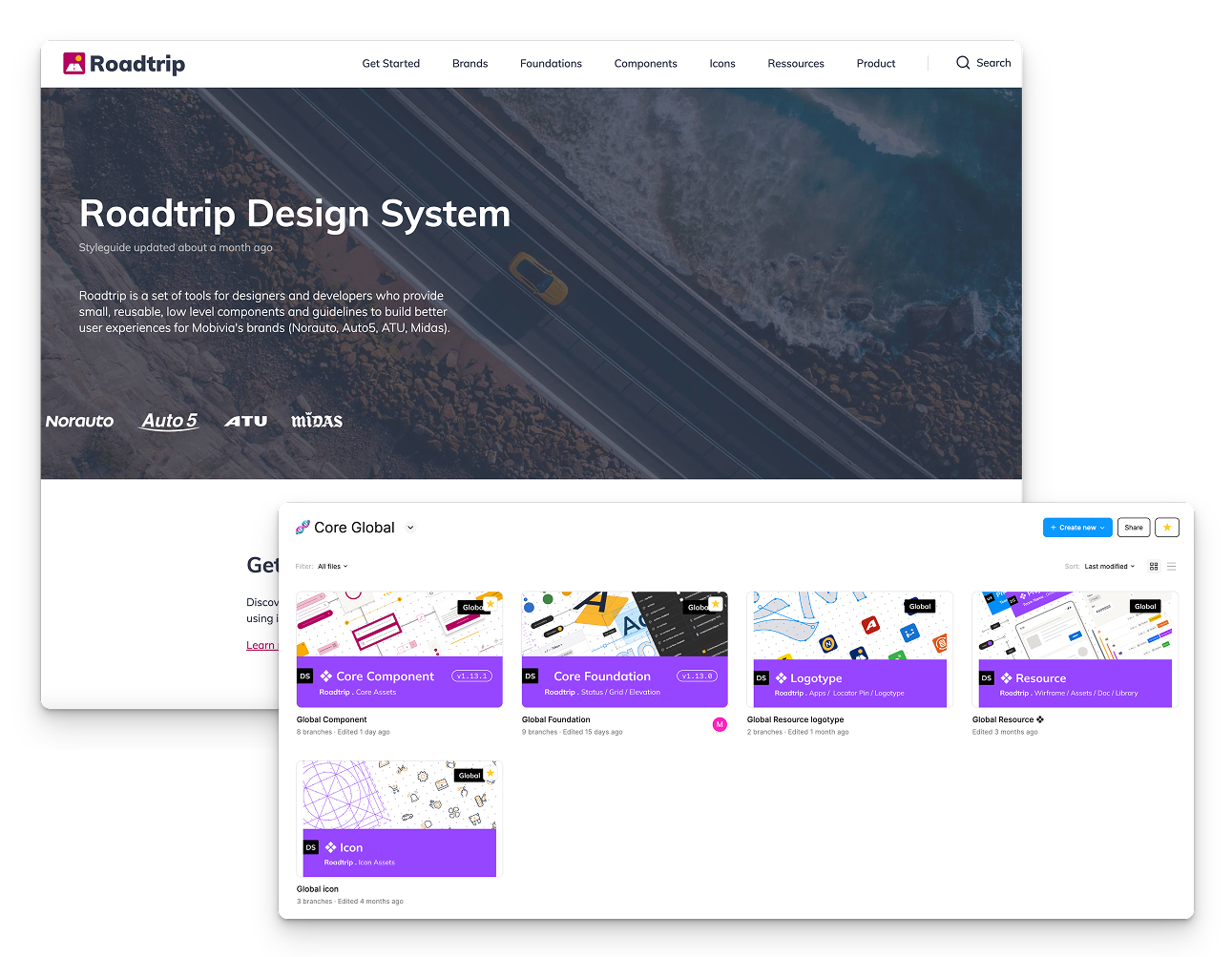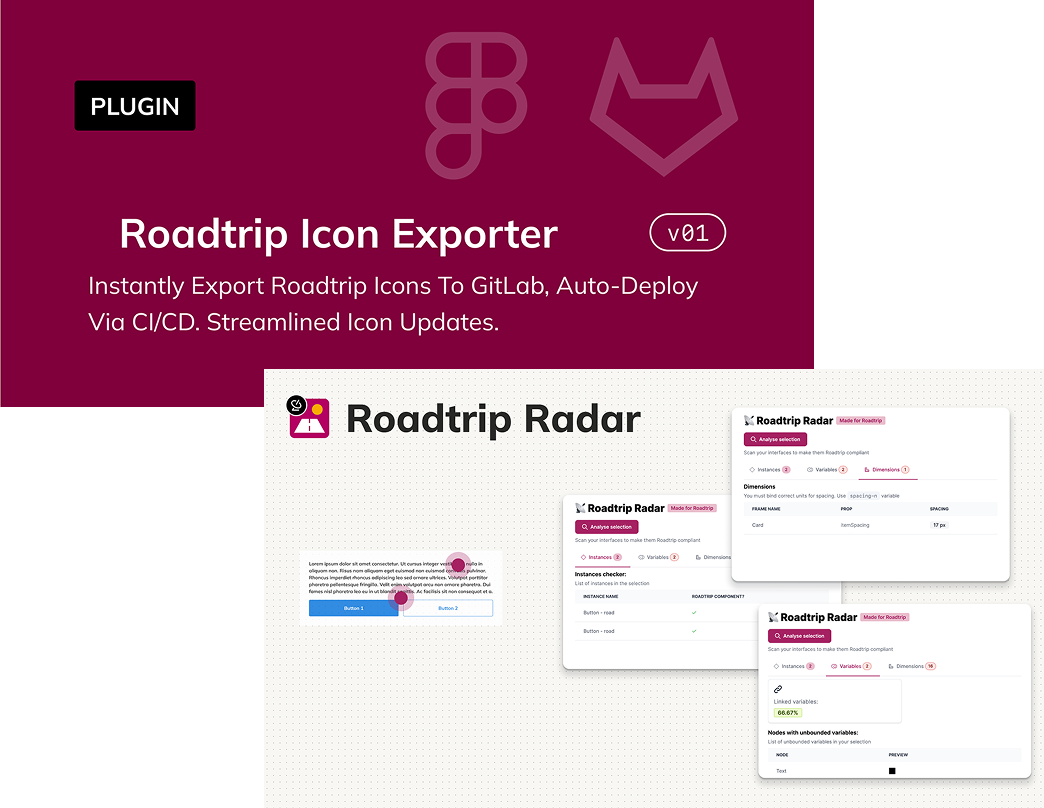Roadtrip Design System: Scaling Design at Norauto
As part of my work at Norauto, I led the creation and implementation of the Roadtrip Design System, a comprehensive and scalable design system designed to unify experiences across multiple brands and countries while ensuring accessibility, governance, and seamless design-to-code workflows.
1. Foundations & Governance
Design Tokens Architecture
I established a robust design token system based on the DTCG standard (Design Token Community Group) to manage:
- Colors and color palettes
- Typography scales
- Spacing and sizing systems
- Light/dark mode theming
Multi-Brand & Multi-Country Theming
Built a flexible theming system to support Norauto's diverse market needs:
- Multi-brand support: Adaptable tokens for different brand identities
- Localization-ready: Country-specific variations while maintaining global consistency
- Theme switching: Seamless transitions between light and dark modes
Design System Governance
Implemented structured rituals to ensure sustainable growth and alignment:
- Weekly Design System Reviews: Regular sync meetings between designers and developers
- Request tracking: Centralized management via GitLab/Jira
- Decision logs: Transparent documentation of changes and rationale

2. Contribution & Collaboration
Clear Contribution Process
Established a four-step workflow for contributing to the design system:
- Proposal: Submit an issue in Figma or GitLab describing the need
- Co-design Workshop: Collaborative sessions with designers and developers to explore solutions
- DS Committee Validation: Review and approval by the design system core team
- Integration & Documentation: Implementation and comprehensive documentation
Cross-Team Alignment
- Multi-BU Workshops: Regular co-creation sessions bringing together stakeholders from different business units
- Local-to-global alignment: Ensuring local market needs integrate with the global design vision
- Open feedback loops: Continuous improvement based on team feedback
3. Documentation & Accessibility
Centralized Documentation Hub
Created a comprehensive documentation ecosystem spanning:
- Storybook: Interactive component library with live examples
- Figma: Design specs and usage guidelines
- Internal site: Centralized knowledge base
Documentation Content
- Component guidelines: Detailed usage instructions for every component
- Accessibility rules: Preparing for the 2030 accessibility law compliance
- Do's & Don'ts: Visual examples showing correct and incorrect usage
- Search functionality: Fast onboarding with intelligent search across all documentation
Accessibility-First Approach
- WCAG compliance checks integrated into the workflow
- Color contrast validation tools
- Keyboard navigation patterns
- Screen reader compatibility testing
4. Tools & Automation
Custom Figma Plugins
Developed specialized Figma plugins to streamline workflows:
- Token export plugin: Direct export of design tokens from Figma to GitLab
- UI Specs generator: Automated generation of developer-ready specifications
- Component sync tools: Keep Figma components in sync with code
CI/CD Pipelines
Implemented automated pipelines for:
- Token synchronization: Automatic sync between Figma variables and codebase
- Component generation: Auto-generate UI components from design specs
- Storybook stories: Automatically create Storybook documentation from components
- Version control: Track changes and maintain design system versioning
5. Experimentation & Innovation
User Testing & Validation
- Regular user testing: Continuous validation of key components with real users
- Prototype testing: Figma prototypes tested before implementation
- A/B testing: Data-driven decisions on component variations
Continuous Improvement Loop
- UX Research integration: Insights from research directly feeding system improvements
- Internal analytics: Track adoption and usage patterns
- Feedback mechanisms: Structured ways to collect and act on team feedback
- Iterative refinement: Regular updates based on real-world usage

Impact
The Roadtrip Design System has enabled Norauto to:
- Accelerate development: Faster time-to-market with reusable, tested components
- Ensure consistency: Unified experiences across all touchpoints and markets
- Scale efficiently: Support multiple brands and countries from a single source of truth
- Improve accessibility: Proactive compliance with evolving accessibility standards
- Foster collaboration: Stronger alignment between design and development teams
✨ The Roadtrip Design System represents a holistic approach to design systems—combining technical excellence, governance, collaboration, and innovation to serve the needs of a complex, multi-market organization.